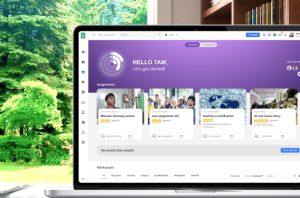Organizations allocate enormous resources attracting top talent, but don’t always dedicate equal resources to training and integrating new hires.
Organizations allocate enormous resources attracting top talent, but don’t always dedicate equal resources to training and integrating new hires. Common wisdom assumes that if you hire a great person, he or she will hit the ground running and become productive quickly and with minimal investment. However, nothing could be farther from the truth. Training and mentorship are critical for successful onboarding. The onboarding process is also the new hire’s first impression of the organization. A positive onboarding experience can increase employee motivation and strengthen his or her commitment to the company. In other words, robust onboarding is not just a “nice to have” feature, it impacts the company’s bottom line. In fact, the Boston Consulting Group found that companies with a robust onboarding process experienced 2.5 times the revenue growth and 1.9 times the profit margin of companies that did not invest in onboarding.
However, onboarding is a complex process with many moving parts. Individual employees, in different departments, will have different onboarding requirements. Also, onboarding is a constantly recurring process, with new hires joining the company at different times. Onboarding will include regulatory and training requirements, both internal and industry-based, meaning that the entire process must be tracked and monitored to ensure it is handled correctly and according to law.
The only way to ensure onboarding best practice is to utilize a computerized approach that customizes and monitors the onboarding process for every position and employee.
How to optimize the onboarding process
Onboarding is important, but a new hire can also be an enormous burden for overworked managers. The right tools can streamline and simplify the process for HR and management while making it more effective and pleasant for the new hire.
Automize the technical stuff
Onboarding begins before the first day on the job as the company prepares a workspace, computer, access to IT systems and security clearance for new hires. HR professionals also recommend sending new hires an email with information on what to expect on their first day, including where to park, who to report to, what forms they will need to fill out and what they will be doing on their first day, as well as background information on the company and their new role. With a robust management platform, these processes can be easily automated, saving managers valuable time and energy and still providing a positive experience for the new hire.
Effective learning
An effective onboarding process encourages employees to learn quickly and efficiently without making them feel like they have been thrown in the deep end. To this end, companies often invest massive resources in providing face to face training, bringing diverse teams together at a physical site, without having the capacity to provide follow up support or accurately assess the effectiveness of the training for a specific worker. A learning management system helps managers build and distribute effective digital training content, accessible at all times to the employee via a unique login. Ultimately, this helps organizations cut costs while supporting a long-term, individual learning process.
For example, Blossom’s learning management platform includes interactive e-learning capacities which let employees learn at their own pace. Managers can track, evaluate and support the learning process quickly and easily. Employees can evaluate the learning process and provide feedback so that management can assess and improve learning modules and provide additional support to employees who need help.
Uniform onboarding in a diverse workforce
There are training modules which are mandatory for all company employees such as security procedures, prevention of sexual harassment, internal policies and more. It can be difficult to ensure the quality and uniformity of mandatory training modules, especially in companies with a geographically diverse workforce. A learning management platform allows management to implement and monitor uniform training across varied locations, without spending a fortune on travel, hotels and training staff. The platform also documents the process to ensure that nothing falls between the cracks and that all employees are properly prepared, no matter where they are located. Uniform learning management is particularly critical in highly regulated fields, where regulations are updated frequently and improper training can lead to critical issues. Learn how Blossom’s learning management platform was utilized to train India’s air force.
Employee integration
Onboarding isn’t only about training. Structured frameworks to help new hires build interpersonal and professional connections in the organization are critical to their success and wellbeing. Research has shown that new employees, who have not yet established a relationship with their coworkers, are less likely to ask questions and seek out information. A study by Gallup showed that employees who were more engaged with their company were 21% more productive. Therefore onboarding should include elements that help the hew hire integrate with his or her team and with the organization as a whole.
When the new hire is able to learn technical information through automated processes and e-learning platforms, this will free up managers and colleagues to dedicate one-on-one time to getting to know the employee and making him or her feel part of the company community. A management system can also connect new hires with experienced workers who can accompany them in the process and support their training and social integration.
Customization
Not all training is uniform: each new hire has specific training, regulatory requirements and knowledge acquisition they must undergo. Handled manually, the customization of learning modules can be a daunting task and therefore is often neglected. A robust, digital learning and training management platform makes it easy for managers to build onboarding flows for specific employees, create targeted training modules and get feedback from the employee during the process. Likewise, learning platforms make it easy for managers to share training modules and build the company knowledge base.
Onboarding done right
It’s not all about the first few months: the onboarding experience will impact a new hire’s success on the job in the long term. With a strong digital management platform, you can onboard employees easily and effectively while saving valuable resources.








